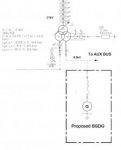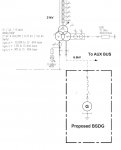Belshazzar
Member
- Location
- Indonesia
Hello everyone. I'm a newbie here. I am currently studying the possibility of inserting a blackstart generator to the existing system as shown in the photo.In doing this , I will be back-powering the aux transformer through its secondary winding and at the same time supplying the AUX BUS for the plant startup when the grid is not available. The delta winding goes to the plant's main generator transformer delta (not shown) and during blackout , is at high impedance state (open HV). The tertiary Y goes to an 11.5MW unity power factor consumer that is required during startup. Granting that my new generator can meet the required startup power, what is the impact on the existing protection at the secondary side (BSDG side)? Any modifcation required on the existing or shall I just define a new set of protection together/coordinated with that of the blackstart generator? Thank you.



